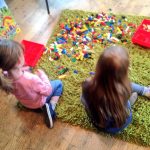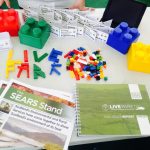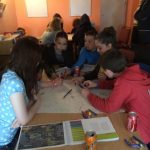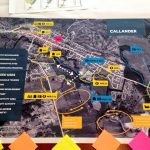
Introducing our ‘Proposed Plan’
Today we are proud to launch the formal consultation on our ‘Proposed Local Development Plan’, but how did we get here, and what does all this mean for you? This blog should provide the background you need.
So, how did we get here?
Last year, you might recall, we had an 11-week public consultation on our ‘Main Issues Report’ (and a further consultation on the ‘Additional Sites Report) where we invited feedback on our ideas for the future physical development of the National Park. This is the key stage for the public to get involved, to share their views whilst the policies and development sites are still being considered. That’s why were we so keen to get as many people involved in that stage as possible. So alongside the usual ways of letting people know this was happening, we tested out some other ways to get people interested and involved.
Of course, we still had printed copies of our plan available to read in libraries or via local Community Councils, but on top of that we went to great lengths to reach out to a broader audience who might not have got involved before – some of the harder-to-reach groups like young people and working-age families.





Click on the images above to enlarge
We used a mixture of ways to let people know the consultation was happening and how they could get involved, from setting up Facebook, Twitter and YouTube pages, to providing local primary schools with boxes of Lego to help them hold workshops where their pupils could help (literally!) build the changes they wanted to see in their local area over the next 20 years. We worked with secondary schools and young people across the National Park via a series of workshops where they shared their thoughts and views about what development was needed for them to see the kind of National Park that they wanted to live or work in. We wanted to capture thoughts from visitors to the area, so we took a stall at the Royal Highland Show to share our plans and get people involved in having their say.
When discussing important issues like planning and development there’s nothing quite like getting together to discuss the issues and potential solutions suggested in our ‘Main Issues Report’ and the ‘Additional Sites Report’ that followed. With that in mind, we attended a number of community meetings and events across the Park. It was good to have this opportunity to discuss our ideas and hearing your feedback.
Since the ‘Main Issues Report’ and ‘Additional Sites Report’ consultations closed at the end of 2014 we have been busy reviewing all the comments we received. We’ve been having follow up discussions with communities and partner organisations which have all helped us draft this new document, our ‘Proposed Plan’ and a suite of documents that support it. More about these later. So, what did we hear during the consultations last year?
Issues that came up
The majority of comments related to individual sites in our communities. The ones that generated the most interest were:
- The proposed Visitor Accommodate at Braeval between Aberfoyle and Port of Mentieth
- The housing proposal on Main Street, Drymen – Lauralfields, and,
- The proposed housing development at Balgibbon Drive (Callander)
We also received feedback across all our proposed policies and strategies.
Consultation responses
Overall, we were delighted that compared to previous consultations of this type we received a significant reduction in responses. Why were we so pleased? Well, because we had put so much time and effort into speaking with our communities and partner organisations early-on, before we had draft the Main Issues Report or Additional Sites Reports. Meetings that took placefrom 2011 until early 2014 with interested parties – from local communities, to organisations like SNH and SEPA who play an important role in helping us decide whether an area is suitable for development, or not. We had also held a number of community design workshops (or ‘charrettes’) that helped inform our proposals. All this meant there were (on the whole) fewer contentious issues and more consensus about what was needed – a real win-win!
So, what changes have we made?
For each of the more contentious sites, we have listened to feedback and conducted thorough investigations into the issues raised. As a result, the proposals for these sites have changed in the Proposed Local Development Plan to those originally presented during the Main Issues Report or Additional Sites Report consultation. Specifically:
- The number of homes proposed for Drymen has been reduced and site-specific design guidance issued;
- The proposal for visitor accommodation in Braeval has been removed to allow for further exploration of options in the area;
- The proposals for Balgibbon Drive, which Park planning officers suggested be brought forward into the 10-year development plan during the LIVE Park phase, have now been reinstated as a longer term, 10-20 year option.
Other differences in the Proposed Local Development Plan are:
- Housing developments of up to three homes in Luss, Tarbet, Gartocharn, Drymen, Croftamie, Gartmore, Aberfoyle and Callander – now need to be ‘affordable houses’ or the developer will need to make a financial payment (‘commuted sum’) towards the provision of affordable housing elsewhere in the local area
- Lifting the long-standing restriction on occupancy of new homes in Loch Lomondside. Previously, occupancy was restricted to those who could demonstrate employment or family reasons for living in the area
- The affordable housing quota for developments of four or more homes in towns and villages has been changed. It will be:
- 50% in the Loch Lomondside villages including Tarbet, Luss, Gartocharn, Croftamie and Drymen
- 33% in the more accessible and pressured Stirling area towns and villages including Callander, Gartmore and Aberfoyle and
- 25% everywhere else
- New sites for development are identified in
- Arrochar
- Balmaha
- Callander
- Crianlarich
- Drymen
- Aberfolyle
- Gartocharn
- Tarbet and
- Killin
The new housing policies have been developed in conjunction with the National Park’s housing partners to ensure a better range of housing types for everyone, including young people and working families.
We have also issued a number of documents which provide additional guidance on a range of topics – from housing to visitor experience and design. All of this makes sure we are providing as much information as possible to help planning applications to be submitted easily and processed quickly. We will explore this further in future blogs.
What do you need to know?
This consultation (on our Proposed Local Development Plan) provides one final opportunity to review changes made as a result of earlier comments. Where further changes are requested, these will be passed to an independent Scottish Government appointed Officer – called a ‘reporter’. This person will review the changes, with any supporting information, along with the position of the National Park Authority and make recommendations before we can ‘adopt’ the Plan. We hope this will be later next year.
So, we hope this blog gives you a quick overview of where we’ve been, where we are now, and how you can get involved, if you still have views you can to share. If you’d like to see a particular topic covered in future blog posts just drop us a line to hello@ourlivepark.com.

